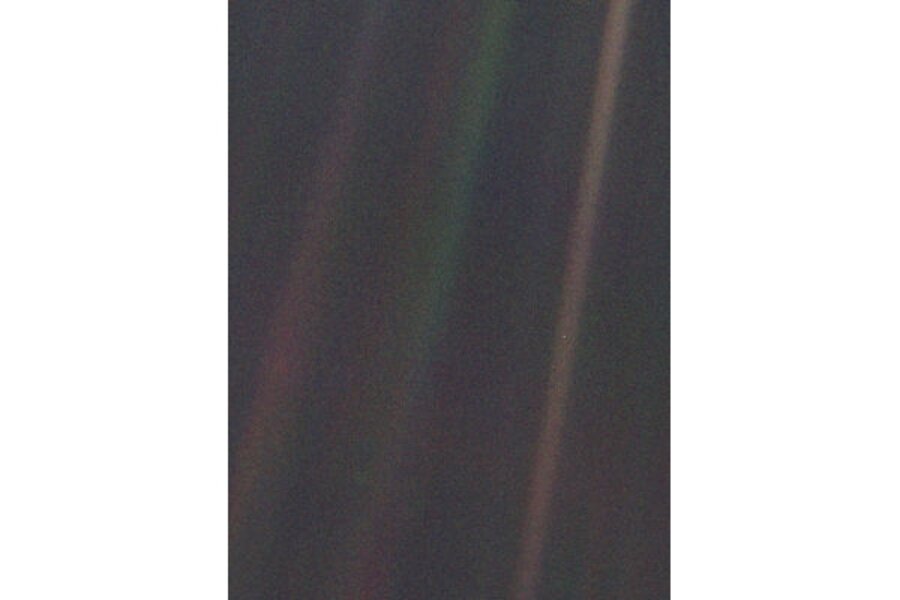How an alien might look at Earth and say: 'Yep, could be life there.'
Loading...
OK. You've got a space probe that did a great job of whacking a comet (Tempel 1) upside the head. It's still got life – and an extended mission – left in it. What do you do with it as it heads toward its next comet rendezvous?
You use it to answer a burning question: If I were an alien cruising the solar system and I spotted a Grobnish-size planet (a planet of roughly the same mass as my home world of Grobnish), how could I tell from an enormous distance if that speck on my screen might be hospitable? Is there any water? If so, how much of the surface does it cover?
Nicholas Cowan, a researcher at the University of Washington, and colleagues have pulled it off: a proof-of-concept approach for looking at a planet from afar (32 million miles and counting) and detecting land and water on a planet's surface and the relative expanse of each.
The work, accepted for publication later this year in the Astrophysical Journal, is suggestively titled: "Alien Maps of an Ocean-Bearing World." You can find the formal research paper in PDF form here. A plain-English description is available here.
How did they do it?
For that, we turn to the Deep Impact spacecraft (now called EPOXI), currently en route to comet Hartley 2. This comet was discovered in 1986, and it swings around the sun once every 6.41 years.
The team used Deep Impact's 30-centimeter (11.8-inch) telescope and its high-resolution imager to look back at Earth.
From 32 million miles away, the imager can still spot objects on Earth's surface at least as small as 62 miles across. But no space telescope in this solar system would ever be able to image a planet orbiting another star at that level of detail. So when the team processed its data, it in effect fuzzed them up to more clearly match the very crude patchiness one might expect from a very, very large space telescope looking at a tiny dot several light-years away.
By doing so, the team used the telescope as a photometer and measured how intense the light from Earth is when viewed through filters of different wavelengths – from ultraviolet, above the violet end of the visible spectrum, to near-infrared, just below the red end of the visible spectrum.
Red, it's land; blue, it's water
They found that light reflected from land showed up most intensely using the near-infrared filter, while the light from oceans showed up best using a filter sensitive to blue. Clouds appeared gray. With few exceptions, clouds seldom appeared over the same place all the time. By taking several images over time and subtracting out the clouds, they could see how land and water is distributed across the planet by noting where the most intense patches of red and blue light were.
If some future astronomer used this approach and saw similar features on an Earth-mass planet orbiting another star, the research paper notes, "it would strongly suggest the presence of continents and oceans, and indicate that the planet was a high priority for spectroscopic follow-up." Such follow-up surely would include a hunt for an atmosphere and an attempt to identify its composition. Gases such as oxygen, carbon dioxide, and methane on an Earthlike planet in a star's "habitable zone" certainly would generate some excitement.
How close are we to having that capability? Not very, according to Sara Seager, a planetary scientist at the Massachusetts Institute of Technology in Cambridge, Mass. She is a member of the team reporting the results.
Oh, Terrestrial Planet Finder, where art thou?
In an e-mail, she explains that to pull off observations like this, astronomers would need a dedicated terrestrial planet finder – a space telescope with a light-gathering mirror between 4 meters and 8 meters across (13 to 26 feet). The Hubble Space Telescope's mirror is 2.4 meters (nearly 8 feet).
And the planet-hunting telescope would need a built-in coronagraph – essentially a disk that can block the light from a planet's parent star so the fainter planet stands out.
"While no Terrestrial Planet Finder telescope is planned, we have hope!" she writes. "Technology development and concept studies are ongoing, but so far the project is very costly."
A TPF, she says, would give astronomers the ability to pick out Earth-mass planets orbiting stars as far as 30 light-years away.





